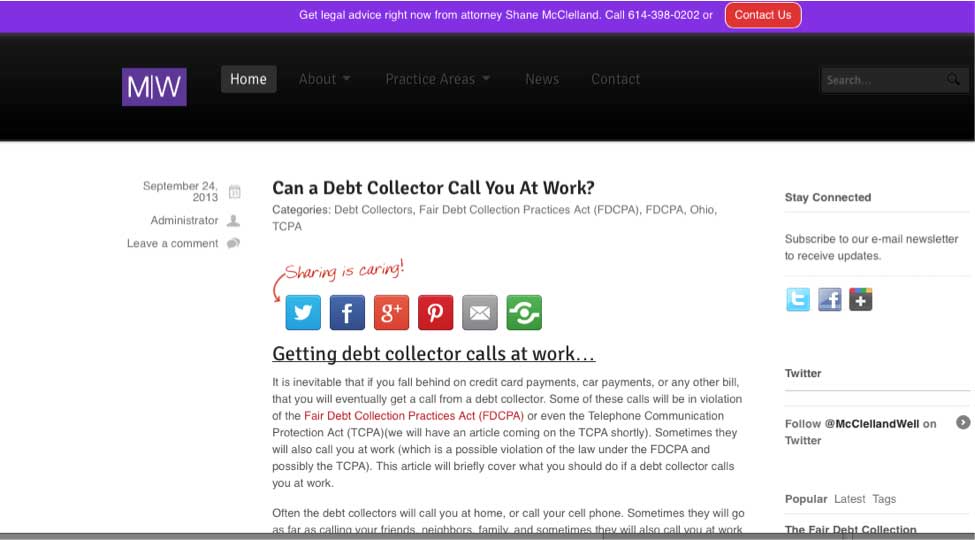These two family and consumer attorneys started their firm in a city where they had no connections. Blogging got new clients flowing.
When you’re a young firm founded in a city where you don’t have any connections, marketing shoots up quite a few notches on the importance scale. For the firm of McClelland|Well LLP, marketing thus quickly became priority number one. The firm immediately dove into marketing, but things weren’t moving as fast as the partners needed them to, and the firm wasn’t seeing much success. “At first we built a website and had decent rankings on Google,” says Shane McClelland, a partner at the firm. “However, we still weren’t getting enough traffic—you had to search for very specific things in order for us to come up.” Then Google changed its algorithms and McClelland|Well LLP lost all the traction it had with the search engine. McClelland knew his firm needed something with staying power, something where his efforts wouldn’t be washed away with every change Google implements. So the firm decided to start blogging, and that’s the decision that changed everything. This case study will examine how McClelland|Well LLP blogged its way to ranking on Google for all the right keywords—the ones that drive clients into the firm.
The Challenge
McClelland|Well LLP is a young firm based in Columbus, Ohio, that focuses on consumer law, domestic relations and LGBT advocacy. The firm was founded on the belief that “a lot can be done with a little; that you do not have to be a giant to change the world.” They were ready to spread that message. The problem was, they didn’t have any connections in their city. Which meant their marketing had to generate clients —or they’d quickly be out of business. 
“Our initial step was to begin posting [ads]on Craigslist.” McClelland says. “Two years ago this worked really well. Google and the other search engines crawled Craigslist and treated it as an important source of information. As a result our ads, phrased well, would often be listed at the top of page one on Google.” This success was fleeting, however. When Google implemented some algorithm changes, the firm nearly all its web traffic. “I don’t remember exactly when it happened, but Google stopped treating Craigslist ads so kindly,” he says. “When that happened, traffic to our website was reduced by around 80 percent. There were months where we had only 10 views of our website.” The firm wasn’t able to attract new clients because they were no longer ranking on Google, and word-of-mouth marketing was hard to come by. “We were left with what amounts to few options,” McClelland says. “We didn’t have a large budget and we couldn’t afford to hire someone to help us as a result.” Unwilling to fold, McClelland knew he needed to step it up big time. He needed to:
- Spread the word about his firm’s existence and the knowledge and experience the partners have
- Drive more traffic to his firm’s website
- Attract clients
The Actions
1. Get To Know Search Engine Optimization (SEO)
McClelland didn’t know anything about SEO, but once the Google algorithm change washed away the progress his firm had made marketing itself online, he knew he had to learn.

“I learned everything I could about SEO and website design,” he says. This allowed him to make his firm’s website look more authoritative and to have better SEO where Google was concerned. “Once I felt like I knew enough to do what we needed to do, we started blogging,” he says. Knowing how SEO works will make a big difference in the articles you write on your blog and in the keywords you target.
2. Start Blogging
Now that McClelland felt confident he could execute what he had learned, he launched a blog on his firm’s website. He set a goal of publishing one blog post a week, and then he was off and writing. It was a slow start, but things eventually started happening. “At first, blogging seemed like we were doing a lot of work for literally no reason—we had zero page views,” McClelland says. “Then one day we had five views, then twenty. I have since become a habitual checker of how many people have visited our website on any given day.” McClelland and his law partner blog with a focus on SEO. “We write every article with an eye toward SEO,” he says. “The point of that is to help the law firm’s website as a whole, but it has led to a plethora of clients finding us because we took the time to create a solid, SEO-friendly article.” By targeting keywords and key phrases that people are searching for, McClelland|Well LLP has been able to attract many clients to the firm.
3. Promote Your Blog Posts
Along with blogging with a focus on SEO, McClelland also uses social media to share his firm’s blog posts and connect with potential clients. “When we publish a new article we push it out through Facebook, Twitter, LinkedIn and Google+,” he says. “Typically after that we also share it on our personal networks.”

By using your social and personal networks, you can begin driving traffic to your firm’s blog. You can also use social media to promote your firm’s older blog posts and get new eyes on them. “We use social media to promote older articles nearly every day,” he says.
4. Have Criteria for Your Content
While McClelland admits his firm doesn’t have very specific criteria when it comes to what topics they blog about, they do have a set of guidelines they follow. “A typical article is started for one of these reasons: we see an interesting news story that relates to what we do; we read a very good article from another website and write a piece about their article; we think of a topic that is already on our website, but reiterate it or freshen it up with a new angle or additional information,” he says. “We [also]use Google to see what we should be writing about. “The Google part is again going back to the SEO component,” he says. “Google has keyword tools that let you see what people are searching for. If you use Google Analytics—and you should be using it, or something similar—you can also see what people searched for that brought them to your website. Google has made this more difficult recently, but it’s still doable. Once you see what people are looking for, and why that term brought up your website, you can determine if you should boost the SEO for it by writing a good article [for your blog].” It’s always a good idea to have criteria when it comes to the content you’ll post on your blog. Even something as simple as the criteria McClelland uses is good enough to get you started. If you want to go a step further, you can develop an editorial calendar, as well as have a running backlog of blog post ideas; that way you always have something on hand to write about. “Building up a reserve of articles would also be a good idea,” he says. “For the times you don’t feel like writing or just don’t have any good ideas.”
The Results
1. 10 New Clients in 90 Days
All the blogging has started to give the firm some serious traction online. “We now average a little over 10 page views a day to our law firm website as a result of blog articles,” McClelland says. “The number doesn’t seem very impressive at first glance. However, when you consider that we were averaging 40 views a month [in total]of our website, prior to the blog, it becomes a huge increase.” So huge, in fact, it even brought in new clients. “The increase has led to at least 10 new clients in the last three months,” he says. And this increase in business has cemented the firm’s love of blogging. “As a result [of the increase]we’ve been learning even more about blogging and what we can do to increase traffic,” he says. “We rank on page one of Google for a few different topics, organically, not with the help of another website, like Craigslist. Our primary focus is now moving our way up to one of the top three spots on page one of Google.”
2. A New Client Through Social Media
While using social media to promote his firm’s blog posts, McClelland actually had some luck attracting—and signing on—a new client. “One of our early LGBT clients actually came from Twitter,” he says. “Through the use of good and local hashtags, we caught the attention of a potential client. They followed us, and then a few months later decided to use our firm for their estate planning. It’s this client that kept me actively using social media in the early days.”
3. Visits to the Website Have Doubled
Blogging regularly and with a focus on SEO has brought a lot more traffic to the firm’s website. The best part is this traffic is now consistent, and growing with each blog post. “Our website hits have more than doubled since we started blogging,” he says. “When comparing months, we are up 300 to 400 percent from some months as compared to a year ago [when we weren’t blogging]. Looking back, we should have been blogging since day one.”
4. 70 Percent of Website Traffic Comes Organically
Due to all the SEO-focused activities that McClelland and his partner do, the firm’s website is now getting most of its traffic organically through Google—meaning the firm doesn’t have to spend money or pay for advertising. “Close to 70 percent of our [website]traffic now comes from organic Google searches,” he says. “That means we show up when people Google their problem, and that means they end up calling us to solve their problem. This should be reason enough to start blogging.” The other 30 percent of traffic to the firm’s website comes from “people clicking through from social media, a few listings that we are part of, and [people]directly typing in our web address.” If you’re still on the fence about blogging, McClelland offers this suggestion: “Just do it,” he says. “It really is that simple. We kept delaying starting a blog because we didn’t think anyone would want to read what we wrote, or that we would not be good enough, or that we didn’t know enough about websites to make the blog successful. However, once we got started with a few articles, it became substantially easier, and after some feedback, we were more than confident that we were good enough to be blogging.”



